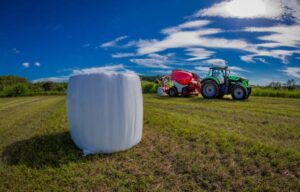A silage wrap manufacturer is a vital resource for farmers who harvest and preserve crops and feed them to ruminants. The silage wrap provides a seal to prevent spoilage and preserve the nutrients in the crop. It also protects the forage from external elements like moisture and air.
5-layer co-extruded blown film technology allows specialized formulas in each layer to offer superior mechanical properties. It is resistant to tears, punctures and impact. For more silage wrap manufacturer, click here.
Quality
 A silage wrap manufacturer produces a range of high-quality films that are designed to meet the needs of farmers. These films are made from linear low-density polyethylene (LLDPE). They can protect hay and other forage crops from damage caused by birds, rain, and wind during storage. They also help to keep out oxygen and prevent spoilage.
A silage wrap manufacturer produces a range of high-quality films that are designed to meet the needs of farmers. These films are made from linear low-density polyethylene (LLDPE). They can protect hay and other forage crops from damage caused by birds, rain, and wind during storage. They also help to keep out oxygen and prevent spoilage.
The quality of a silage wrap film depends on its tensile strength, which is the amount of stress it can withstand before it tears. It should be strong enough to prevent tearing and puncture, and it should also have reasonable moisture control.
A good quality silage film is able to resist bird and rodent damage, which is critical for preserving the nutrient-dense feed. It should also be UV resistant to avoid damage from prolonged exposure to the sun. In addition, it should be able to resist the corrosive acids that can cause pitting in bales. A good quality silage wrap should also be easy to cut, which makes it easier for contractors to use in the field.
Durability
The durability of silage plastic film is an essential factor for farmers to consider. It helps them preserve crops and prevent mould growth, which can affect the quality of the feed. The film also prevents oxygen from entering the bale and preserves nutrients in the crops. It can also protect the feed from bugs, rodents, and other damage. For more silage wrap manufacturer, click here.
The material used to make the silage wrap is premium metallocene polyethylene. This type of film is highly durable and able to withstand the pressure of fodder plants with thorny stems. It also has high puncture and tear resistance, which allows it to withstand the abrasion of machinery. It is available in a variety of sizes and widths.
The SILOBAL’ECO wrapping is made of premium multi-layer blown film using high-quality raw materials to ensure good adhesion. It also features 7-layer co-extrusion technology, allowing it to have excellent mechanical properties. The film is resistant to tears and punctures, and it runs well on all types of equipment, including 3D machines and square bale wrappers. It is also easy to use and maintain.
Eco-friendly
A silage plastic wrap is an eco-friendly way to protect your bales from harmful elements. It is made of high-quality materials that don’t interfere with your crop and are easily recyclable. It also provides a better storage environment and increases the quality of your forage.
Bales are often damaged by factors such as weather conditions and animals. This damage and spoilage can reduce the quality of the forage and limit its fermentation process. However, this can be avoided by wrapping the bales promptly and selecting a storage site that is free of debris. In addition, the quality of the forage can be improved by limiting the availability of oxygen in the bale.
Trioplast offers a range of high-quality stretch films for silage packaging that is made from recycled raw materials and has excellent oxygen barriers. One such product is Unterland R, which contains a high level of post-consumer recycled polyethylene and offers exceptional mechanical properties and cling capacity. For more silage wrap manufacturer, click here.
Economical
Grass silage is an effective way for farmers to preserve the nutritional value of their crops. It also helps them save money on feeding their livestock during the winter months. This process involves cutting green feed and then storing it in anaerobic conditions. It is essential to ensure that the forage doesn’t dry out.
 A suitable
A suitable